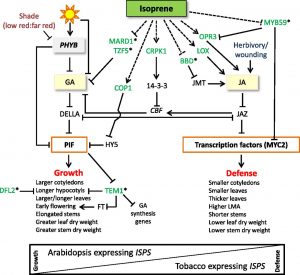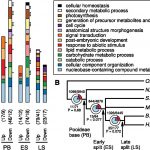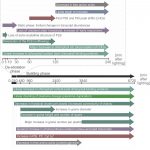Effects of Isoprene on Plant Growth
Abiotic stress conditions such as drought and salt stress increase isoprene synthesis and emission in many plant species. The carbon and energy cost of isoprene production has been found to vary depending on the plant species and environmental conditions. For example, trees that normally produce isoprene, such as eastern cottonwood (Populus deltoides), consume about 2%, while kudzu (Pueraria montana) can consume up to 64% of photosynthetic C for isoprene production. Given the potential costs associated with isoprene emission, it is not surprising that the property of isoprene emission has been lost in some species: Arabidopsis (Arabidopsis thaliana) and tobacco (Nicotiana tabacum), for example, do not produce isoprene A key enzyme in isoprene production is isoprene synthase (ISPS) which converts  dimethylallyl diphosphate into isoprene. Understanding how isoprene affects plant growth and physiology will allow researchers to determine whether ISPS will be a beneficial trait to be reintroduced to plants, especially for the purpose of crop improvement. With this strategy in mind, Zuo et al. (10.1104/pp.18.01391) have transformed Arabidopsis with an ISPS gene from Eucalyptus globulus. The regulatory mechanisms of photosynthesis and isoprene emission in these transformed plants were found to be similar to those of native emitters, indicating that the regulatory components of isoprene emission are not specific to isoprene-emitting species. The leaf chlorophyll and carotenoid contents of the Arabidopsis transformants were enhanced by isoprene, which also had a marked positive effect on hypocotyl, cotyledon, leaf, and inflorescence growth. By contrast, leaf and stem growth was reduced in tobacco engineered to emit isoprene. The expressions of genes belonging to signaling networks or associated with specific growth regulators (e.g. gibberellic acid and jasmonic acid) were altered by isoprene emission as were genes involved in stress tolerance. The authors propose that isoprene likely executes its effects on growth and stress tolerance through direct regulation of gene expression, and that the enhancement of jasmonic acid-mediated defense signaling by isoprene may trigger a growth-defense tradeoff leading to variations in the growth response.
dimethylallyl diphosphate into isoprene. Understanding how isoprene affects plant growth and physiology will allow researchers to determine whether ISPS will be a beneficial trait to be reintroduced to plants, especially for the purpose of crop improvement. With this strategy in mind, Zuo et al. (10.1104/pp.18.01391) have transformed Arabidopsis with an ISPS gene from Eucalyptus globulus. The regulatory mechanisms of photosynthesis and isoprene emission in these transformed plants were found to be similar to those of native emitters, indicating that the regulatory components of isoprene emission are not specific to isoprene-emitting species. The leaf chlorophyll and carotenoid contents of the Arabidopsis transformants were enhanced by isoprene, which also had a marked positive effect on hypocotyl, cotyledon, leaf, and inflorescence growth. By contrast, leaf and stem growth was reduced in tobacco engineered to emit isoprene. The expressions of genes belonging to signaling networks or associated with specific growth regulators (e.g. gibberellic acid and jasmonic acid) were altered by isoprene emission as were genes involved in stress tolerance. The authors propose that isoprene likely executes its effects on growth and stress tolerance through direct regulation of gene expression, and that the enhancement of jasmonic acid-mediated defense signaling by isoprene may trigger a growth-defense tradeoff leading to variations in the growth response.



